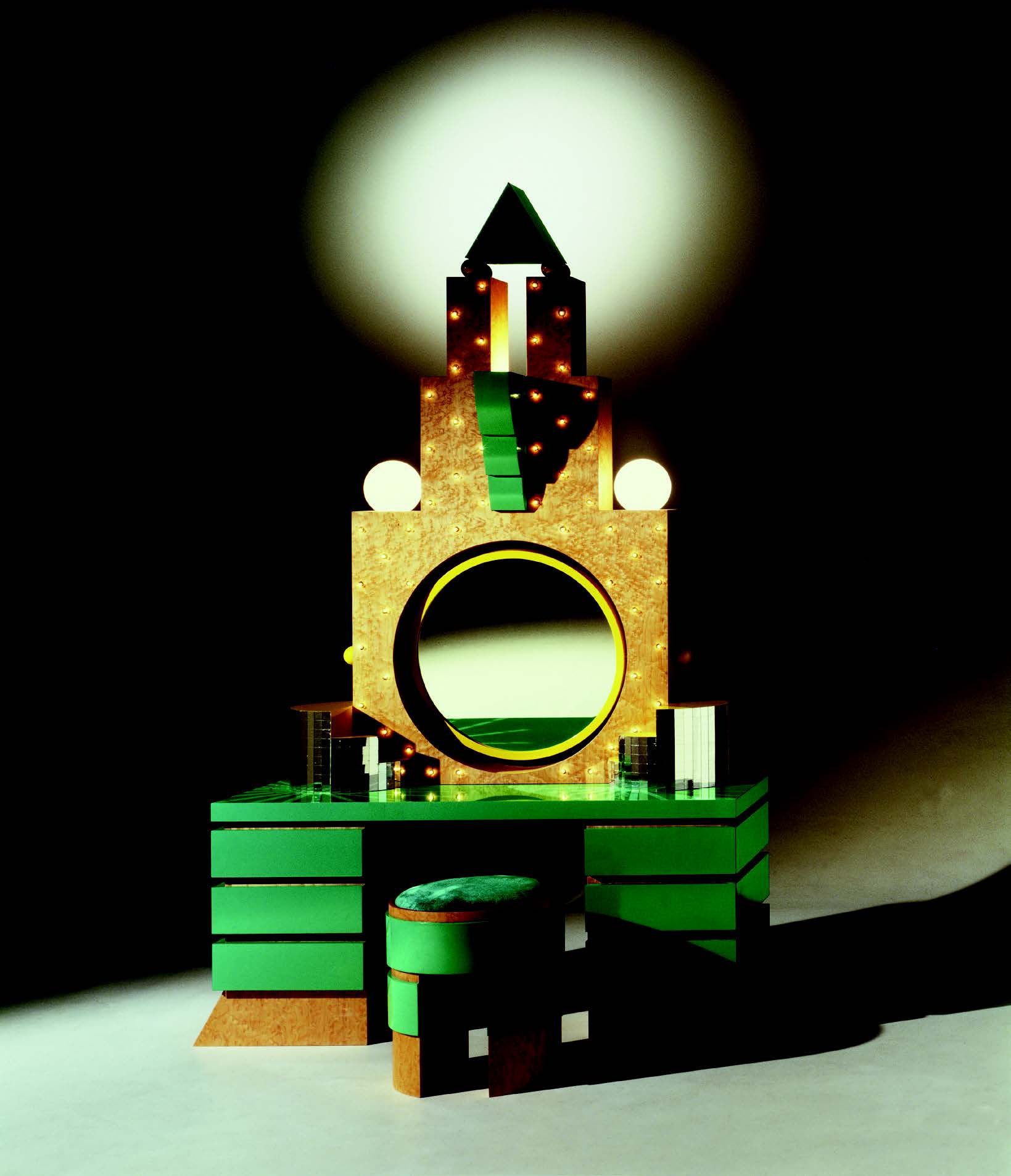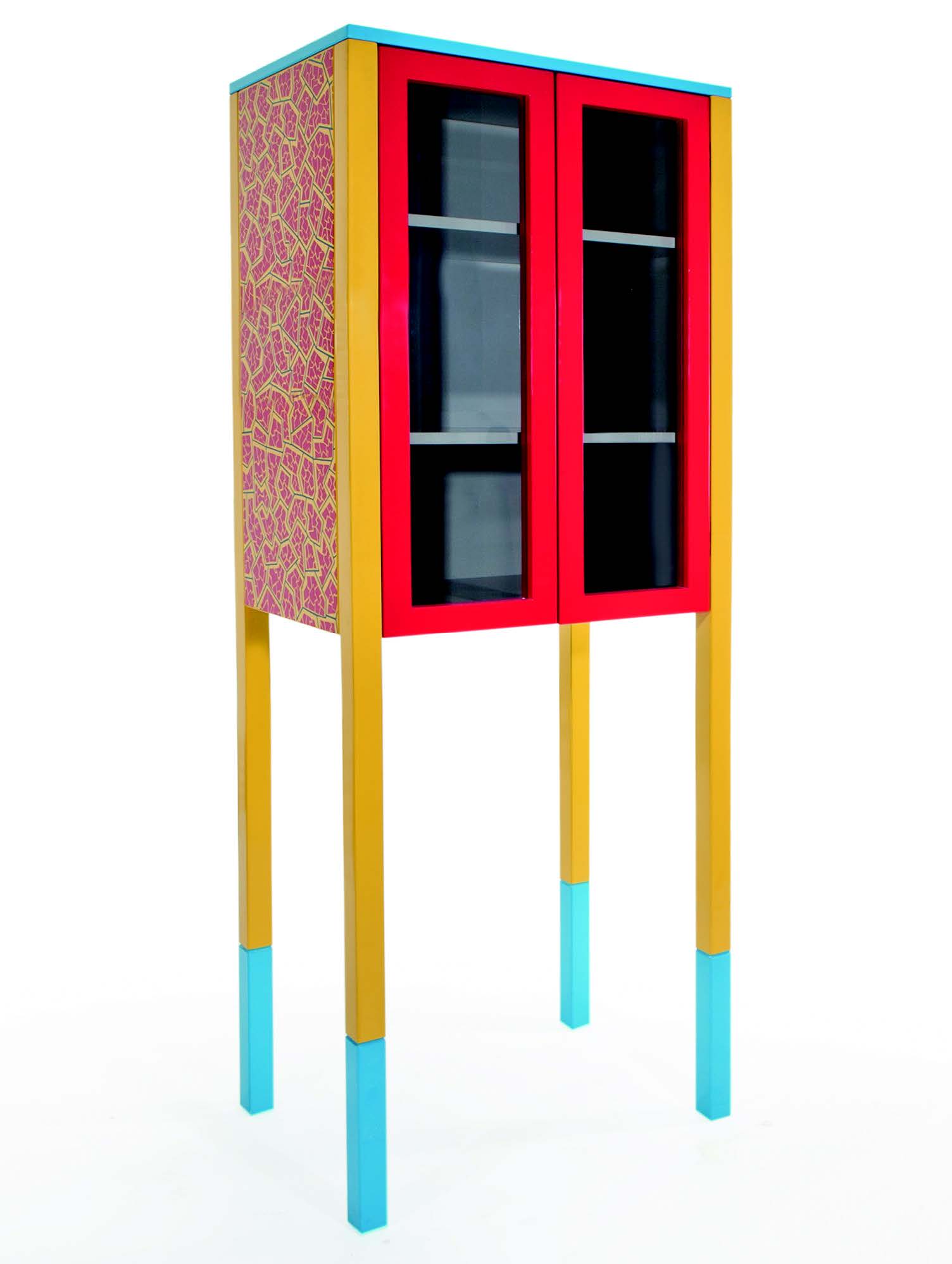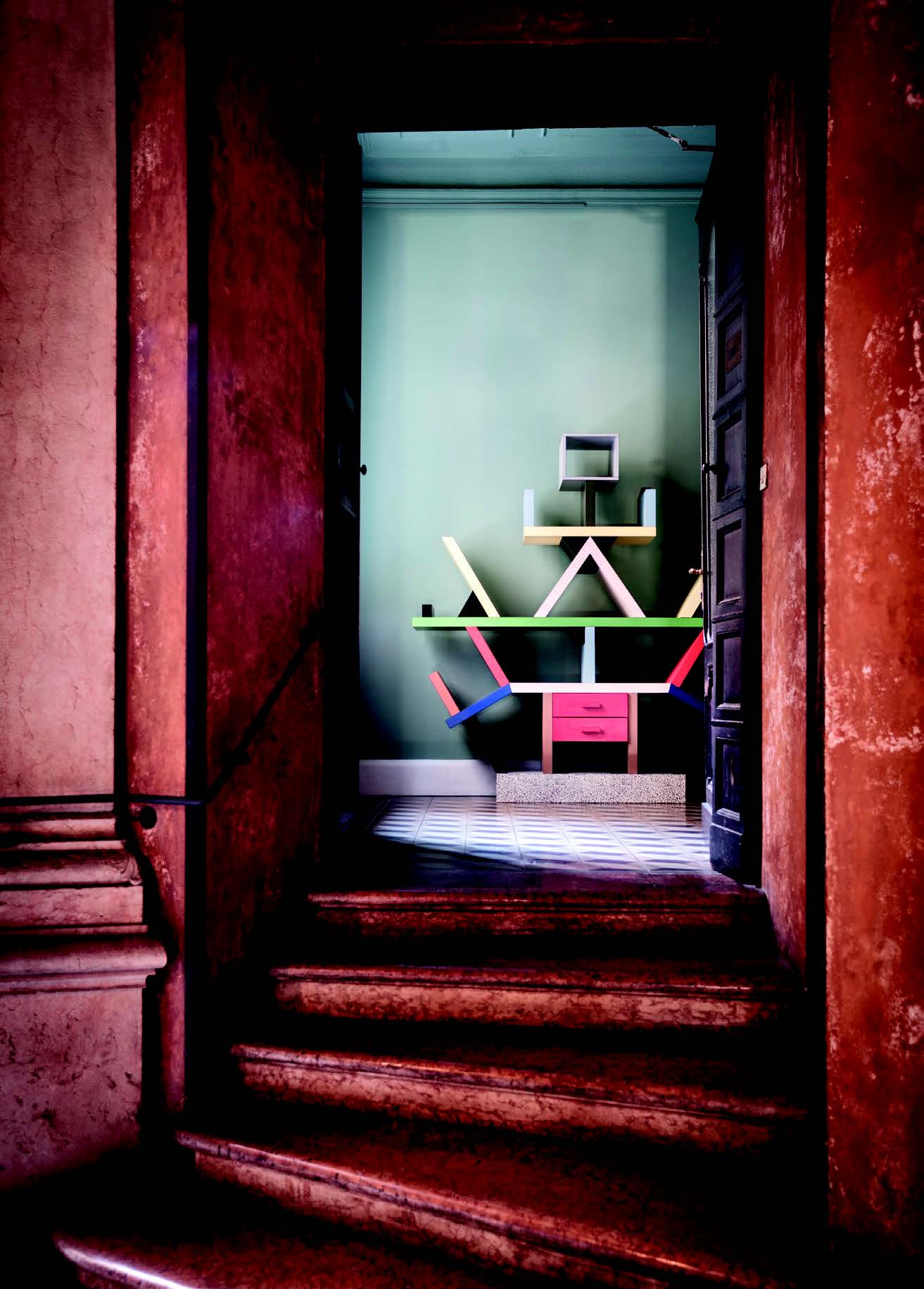The Memphis Group – the ultimate guide

Famously described as “a shotgun wedding between Bauhaus and Fisher-Price”, the Memphis group was much more than a blast of colour and plastic

Memphis design defined a generation and even set the look of 1980s fashion, music, film and architecture. Chanel designer Karl Lagerfeld furnished his entire apartment in Monte Carlo with the collection; David Bowie amassed a large collection including the work of 19 designers which were sold in Sotheby’s Bowie Collector sale in 2016. Bowie said of the designs: “Each piece of furniture offered a plethora of possibilities, options and inconclusive ends. It sucked on the breath of pop culture with gusto and an enthusiasm that was delightful to witness.” Memphis group’s work is still produced and collected today and with the rise of maximalism, which many trace back to the rule-breaking group, is enjoying a renaissance.
Early days of the Memphis Group
The group was forged in a smoked-filled Milan apartment on the evening of December 11, 1980. The flat’s owner was the Austrian-born, Italian architect and designer Ettore Sottsass (1917- 2007) and, while he was in his sixties, the room buzzed with a group of twenty-something designers looking for a new direction of form and function.
Amid the wine and chat, they were listening to Bob Dylan’s Stuck Inside of Mobile with the Memphis Blues Again, and the group found its name – a two-fold reference to the ancient capital of the Egyptian pharaohs and the birthplace of Aretha Franklin and Elvis Presley in Tennessee. Ancient and contemporary, sacred and pop, high and low art. While simultaneously both serious, in its short lifetime, the group went on to cause a sensation, breaking the codes of 20th-century modernism and challenging ideas of good taste. Its influence became a key feature in the decade’s design, fashion, architecture, music and film.

First Show
The group’s first exhibition in Milan on September 18, 1981, included 55 items and was called Memphis, The New International Style. Under the artistic direction of Barbara Radice, it challenged the early 20th-century’s international style epitomised by Le Corbusier, Ludwig Mies van der Rohe, and the Bauhaus.
The opening was attended by over 2,500 people and the impact was immediate and international.
It also attracted unprecedented media coverage, suddenly making furniture and product design as newsworthy as couture fashion.
Sottsass himself was snapped with his youthful team of international designers behind the ropes of a boxing ring-inspired bed – the Tawaraya by Masanori Umeda (b. 1941). Named after a luxury hotel in Kyoto, the bed was one of the most iconic designs from Memphis’s first collection.
Memphis Group Heyday
In addition to Italians and expatriates gathered in Milan, Sottsass invited international designers to contribute. In total, 56 designers participated in the Memphis project, including eight from the UK. Design described as ‘postmodern’ came to represent the era of free-market capitalism of the decade.
Memphis spokesperson Barbara Radice describes the group’s irreverent approach to materials as the “unexpected marriage” of “precious and non-precious, like wood, plastics, lacquers, brass, mirrors, aluminium, and fabrics, and the overlapping of rough and smooth, soft texture and sharp edges, plain and patterned surfaces, acid colours and pastel shades… like numerous tiny electric discharges,” in order to “turn a piece of furniture into a complex system of communication.”
Memphis furniture was characterised by the group’s use of plastic laminate (a plastic made from layers of paper, wood or fabric, compressed and bonded together with resin). Until then, laminate was used for functional applications like on kitchen worktops. Memphis embellished this basic, low-priced material with bold pattern and colour and made a feature of it.

International Influences
Memphis designs stem from a wide-ranging mix of cultural references. Nathalie Du Pasquier’s (b. 1957) textiles were inspired by African fabrics following her travels to the continent as a young women. Sottsass had also travelled widely and was strongly affected by structures and philosophies found across the world, from Indian traditions to American pop culture.
The Ashoka lamp designed by Sottsass for Memphis’s first collection, was inspired by his journey to India in the early 1960s and named after an ancient Indian emperor.
As early as 1985, Sottsass began to distance himself from the group. He said: “It’s like a love story.
When you get used to it, you have to quit.” The year signalled a significant shift in the collective’s style. In the words of Barbara Radice, Memphis’s artistic director, “The 1985 exhibition evokes smoke-filled urban atmospheres, the streets of Blade Runner or a post-nuclear hero roaming scorched landscapes. By breaking all the rules, the group created an exciting new sense of freedom where everyday objects could create revolutions in style taste and design.”
The Carlton cabinet

The Carlton cabinet is one of Sottsass’s most iconic designs.
It is characterised by its combination of anthropomorphic silhouette, totemic profile, bold colours and cheap materials – medium-density fibreboard (MDF) – and plastic laminate.
Combining a room divider, a sideboard and a bookcase, its configuration of partitions and voids appear haphazard but has a rational structure of equilateral triangles supporting the shelves.
The Carlton immediately became a design icon, entering the collections of the Cooper Hewitt Smithsonian Design Museum in New York, as well as the personal collections of Karl Lagerfeld, then creative director of Chanel, and David Bowie. Bowie said of the piece: “Even now, the jolt, the impact, created by walking into a room containing a cabinet by Memphis … is visceral. It’s true that you can’t put another piece of furniture within the same space. There is just no aesthetic room.”
The Plaza

The Plaza vanity was one of the few pieces designed by the American architect and designer Michael Graves (1934-2015) for Memphis’s first collection, but immediately became one of the collective’s most famous designs. His work is distinct from other Memphis pieces, with influences drawn from art deco and old Hollywood glamour.
Named after the famous Plaza Hotel in New York, Graves’s design presents the profile of a characteristic Manhattan skyscraper, with small lights suggestive of a starry night. Like many other Memphis designs, the Plaza evokes luxury and affluence, yet its materials consist of cheap medium-density fibreboard (MDF) coated in maple veneer, paint and mirror plating.

Expert View on the Memphis Group
We asked Joy McCall, Lyon and Turnbull’s senior specialist in decorative arts and design for her insights into the Memphis group
 How influential was the movement?
How influential was the movement?
Memphis was one of the most influential movements of the late 20th century and the most significant expression of post-modernism – even though it only existed for a short period of time, namely 1981-1987. It was an international collective of Europeans and Americans, and also included two Japanese designers – Shiro Kuramata and Masanori Umeda; but its reach was global. If you wanted to summarise the aesthetic of the 1980s you only need to look at the work of the Memphis group. The range of items they produced was broad and encompassed furniture, lighting, ceramics, glass, carpets, textiles, table wares and jewellery.
Their influence impacted: fashion (Esprit shops were designed by Ettore Sottsass and the clothes reflected the style too), film (Back to the Future II – the future looks very Memphis in ethos) and television (apparent in the visual presentation of MTV).
What Memphis achieved was the culmination of a break with modernism. They were preceded by Pop and Radical Design, but Memphis was a turning point. After that, other designers gained confidence to question everything and to imagine infinite new possibilities.
Which of the group is broadly considered to be the most talented?
The majority of people, if asked, would say Ettore Sottsass, because he had such a varied career that extended over 60 years. Memphis represented just a brief moment in his illustrious career. He was a man who constantly reinvented himself. In an upcoming sale we are offering an oil on canvas painting by him from about 1950. It is representative of a period when he was involved with Spazialismo, a movement founded by the renowned artist Lucio Fontana. Fontana believed that art should embrace science and technology and where possible include a spatial dimension, as well as colour, movement and sound.
Sottsass was hired by Olivetti in 1956 as a design consultant. In 1969, with Perry King, he created the Valentine portable typewriter. An example owned by David Bowie realised £45,000 when offered for sale in 2016.
Sottsass’s influence on this design icon has been likened to the impact Steve Jobs had at Apple in grasping the importance of product presentation. Here, Sottsass sheathed the typewriter in red and named it ‘Valentine’. It proved to be a winning formula, with David Bowie even choosing to write his lyrics on his Valentine.
Sottsass not only founded Memphis – he was the designer who held the group together. Previously, he had been involved with Studio Alchimia alongside Alessandro Mendini (the other leading anti-design exponent) but then left to form Memphis.
Yet when he felt that Memphis was attracting too much media attention, he chose to leave the group in 1985 to refocus on his architectural practice.

The famous description of Memphis being ‘Bauhaus meets Fisher Price’- how true is that?
It is fair if you view Memphis design from a purely visual perspective. Memphis design can be characterised by naively constructed forms with illogical proportions, arrangements and use of unexpected materials. However, this statement fails to understand the philosophy and motivation behind the work.
Memphis was about rejecting the principles and values held by Modernism in favour of an exploration of new possibilities and an intentional engagement of the senses.
Memphis design was intended to stimulate emotions and its works do indeed convey a spirit of happiness and pleasure with a degree of humour thrown in.
Which of the designers’ work is the most sought-after today?
Based on prices achieved at auction the answer has to be between Ettore Sottsass and the Japanese designer Shiro Kuramata (1934-1991). Sottsass’s top price of £68,750 was realised for a Casablanca sideboard designed in 1981 and offered as part of the David Bowie sale in 2016. However, Kuramata’s designs have steadily realised more than this, though not all of the works he produced during this period came directly under the Memphis umbrella. The record for a work by him is €361,500 for the Homage to Josef Hoffmann chair sold in 2014.
What would be the holy grail Memphis piece?
Most of the rarest pieces of Memphis design are now in museums, so it is perhaps more realistic to think about obtaining some of the most iconic pieces of Memphis design instead.
The Carlton room divider designed in 1981 is perhaps the most widely recognised piece with its plastic-laminate surfaces, its seemingly random combination of brightly-coloured elements and its defiant rejection of expected forms. It no longer assumes that the composition should be assembled from verticals and horizontals, rather angles are introduced in many of the components. It also rather defies definition because this could be a bookcase, a sideboard or a room divider – whatever it is, it is question-provoking.

The other well-known piece of Memphis design is the Boxing Ring Tawaraya Seating Area designed by Masanori Umeda; which featured in the famous photograph of 1981 that included most of the leading designers at the opening of their first exhibition in Milan. It has four intended functions – a shrine, a platform, a conversation area and a bed. It signified a fusion between the East and the West and took its name from a luxury hotel in Kyoto.
Are they collectors’ pieces or used for their design potential?
A Memphis pieces are not common. They were not generally mass-produced; but they crafted works not industrial pieces, because they were intricate and complex in design. Many pieces are now in museum collections so can be seen but not acquired.
In my experience there have been people who collected Memphis but now buyers tend to be looking for a statement piece because it is both fun and perhaps still feels slightly quirky.

Will they stand the test of time?
They have already! If they hadn’t we wouldn’t still be talking about them four decades later. Memphis has been the subject of popular museum exhibitions and the influence of these designers lives on, as fashion revisits the 1980s. The Memphis designers released creativity from the implicit rules handed down by Modernism and permitted a future generation to think ‘outside the box’, understanding that there really aren’t any rules and encouraging them to imagine new possibilities.
Have you got a favourite designer?
I like Nathalie du Pasquier’s Riveria carpet, designed in 1983 and worked in hand-knotted wool. It evokes memories of hot sunny days spent cheerfully relaxing with friends and family by a pool, on a beach or open-water swimming somewhere.

